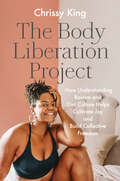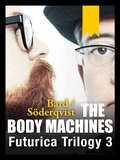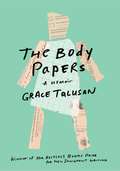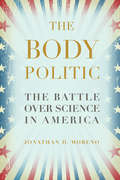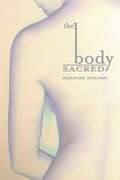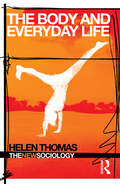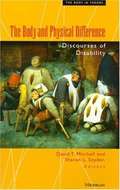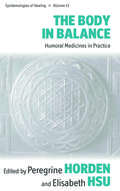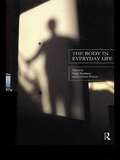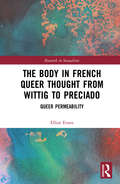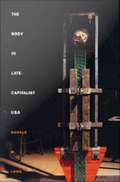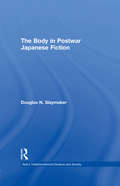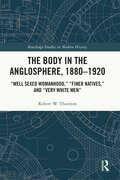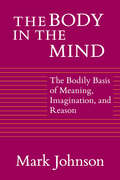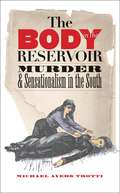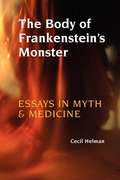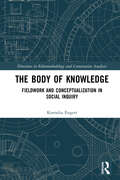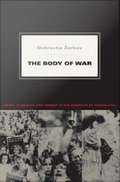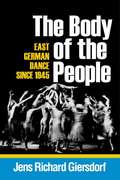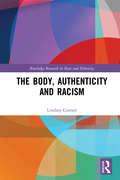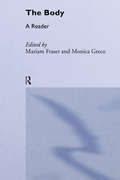- Table View
- List View
The Body Liberation Project: How Understanding Racism and Diet Culture Helps Cultivate Joy and Build Collective Freedom
by Chrissy KingFrom author and wellness personality Chrissy King, an exciting, genre-redefining narrative mix of memoir, inspiration, and activities and prompts, with timely messages about social and racial justice and how the world needs to move beyond body positivity to something even more exciting and revolutionary: body liberation.When Chrissy King first joined a gym, she had one goal in mind: to &“get skinny.&” In pursuit of this goal, she fell into the all-too-common cycle of &“not enough-ness&”; no matter what she achieved, there was always something she felt she needed to change about her body, her appearance, herself. This made her realize the most liberating truth of all: She was not the problem. Diet and fitness industries rooted in white supremacy were the problem; Eurocentric and carefully manufactured beauty standards were the problem; discourses telling her that her happiness was directly tied to her physical appearance were the problem. So she created an actionable method to redefine the relationship we have with our bodies, thereby achieving a sense of self-worth that is completely separate from how we look.The Body Liberation Project is about finding actual freedom in our bodies by discovering strength and aspects of fitness, movement, and eating that work for YOU. It&’s about realizing that the goal is not to look at our bodies and love everything we see; it&’s to understand that at our essence we are so much more than our bodies. But it&’s also about recognizing the harsh realities that prohibit people in marginalized bodies from being able to do so. Society constantly bombards those who fall outside Eurocentric standards of beauty (think Black, fat, trans, etc.) with the message that they are less attractive, and part of the journey toward body liberation is examining your own privilege, acknowledging the harm you may be causing others, and mourning your old ideas about what a body &“should&” look like. Recognizing that none of us are free until all of us are, Chrissy King shares the wisdom, the tools, and the inspiration to motivate readers to find body liberation and, even more important, to pass it on.
The Body Machines
by Alexander Bard Jan SöderqvistThe final episode of The Futurica Trilogy. It departs from repeated questions about the Death of the Individual in the Age of Interactivity. The authors rehabilitate Descartes old concept of the body machine and transform it into the foundation of a very anti-cartesian, materialist image of humanity, relevant for the new, emerging paradigm--we're entering The Age of The Body Machines.
The Body Papers
by Grace TalusanBorn in the Philippines, young Grace Talusan moves with her family to a New England suburb in the 1970s. At school, she confronts racism as one of the few kids with a brown face. At home, the confusion is worse: her grandfather’s nightly visits to her room leave her hurt and terrified, and she learns to build a protective wall of silence that maps onto the larger silence practiced by her Catholic Filipino family. Talusan learns as a teenager that her family’s legal status in the country has always hung by a thread—for a time, they were “illegal.” Family, she’s told, must be put first. <p><p> The abuse and trauma Talusan suffers as a child affects all her relationships, her mental health, and her relationship with her own body. Later, she learns that her family history is threaded with violence and abuse. And she discovers another devastating family thread: cancer. In her thirties, Talusan must decide whether to undergo preventive surgeries to remove her breasts and ovaries. Despite all this, she finds love, and success as a teacher. On a fellowship, Talusan and her husband return to the Philippines, where she revisits her family’s ancestral home and tries to reclaim a lost piece of herself. <p> Not every family legacy is destructive. From her parents, Talusan has learned to tell stories in order to continue. The generosity of spirit and literary acuity of this debut memoir are a testament to her determination and resilience. In excavating such abuse and trauma, and supplementing her story with government documents, medical records, and family photos, Talusan gives voice to unspeakable experience, and shines a light of hope into the darkness.
The Body Politic
by Jonathan D. MorenoA Kirkus Reviews Best Book of the Year and Scientific American Book Club selection"Moreno pulls apart the debates on eugenics, abortion, end-of-life decisions, embryonic stem-cell research, reproductive cloning, chimeras and synthetic biology, among others, carefully reassembling what's at stake for each side. In graceful, sparkling prose, he illuminates intricate threads of history and complex philosophical arguments. . . . Highly recommended for anyone interested in the[se] vital issues." -Kirkus Reviews (starred review)We have entered what is called the "biological century" and a new biopolitics has emerged to address the implications for America's collective value system, our well-being, and ultimately, our future. The Body Politic is the first book to recognize and assess this new force in our political landscape-one that fuels today's culture wars and has motivated politicians of all stripes to reexamine their platforms. As Moreno explains the most contentious issues, he also offers an engaging history of the intersection between science and democracy in American life, a reasoned (and often surprising) analysis of how different political ideologies view scientific controversies, and a vision for how the new biopolitics can help shape the quality of our lives.Jonathan D. Moreno is the David and Lyn Silfen University Professor at the University of Pennsylvania and the editor-in-chief for the Center for American Progress' online magazine, Science Progress. He divides his time between Philadelphia and Washington, DC.
The Body Populace: Military Statistics and Demography in Europe before the First World War (Transformations: Studies in the History of Science and Technology)
by Heinrich HartmannHow data gathered from national conscriptions in pre–World War I Europe influenced understandings of population fitness and redefined society as a collective body. In pre–World War I Europe, individual fitness was increasingly related to building and preserving collective society. Army recruitment offered the most important opportunity to screen male citizens' fitness, raising questions of how to define fitness for soldiers and how to translate this criteria outside the military context. In this book, Heinrich Hartmann explores the historical circumstances that shaped collective understandings of fitness in Europe before World War I and how these were intertwined with a fear of demographic decline and degeneration. This dynamic gained momentum through the circulation of knowledge among European nations, but also through the scenarios of military confrontations. Hartmann provides a science history of military statistics in Germany, France, and Switzerland in the decades preceding World War I, considering how information gathered during national conscriptions generated data about the health and fitness of the population. Defined by masculine concepts, conscription examinations went far beyond the individuals they tested and measured. Scholars of the time aspired to pin down the “nation” in concrete numerical terms, drawing on data from examinations to redefine society as a “collective body” that could be counted, measured, and examined. The Body Populace explores the historical specificity and contingency of data-gathering techniques, recounts their uses and abuses, and provides a timely contribution to the growing historiography of Big Data. It sheds light on a crucial moment in nineteenth and early twentieth century European history—when statistical data and demographical knowledge shaped new notions of masculinity, fostered fears of degeneration, and gave rise to eugenic thinking.
The Body Project: An Intimate History of American Girls
by Joan Jacobs Brumberg"Timely and sympathetic . . . a work of impassioned advocacy. " --People. A hundred years ago, women were lacing themselves into corsets and teaching their daughters to do the same. The ideal of the day, however, was inner beauty: a focus on good deeds and a pure heart. Today American women have more social choices and personal freedom than ever before. But fifty-three percent of our girls are dissatisfied with their bodies by the age of thirteen, and many begin a pattern of weight obsession and dieting as early as eight or nine. Why? In The Body Project, historian Joan Jacobs Brumberg answers this question, drawing on diary excerpts and media images from 1830 to the present. Tracing girls' attitudes toward topics ranging from breast size and menstruation to hair, clothing, and cosmetics, she exposes the shift from the Victorian concern with inner beauty to our modern focus on outward appearance--in particular, the desire to be model-thin and sexy. Compassionate, insightful, and gracefully written,The Body Project explores the gains and losses adolescent girls have inherited since they shed the corset and the ideal of virginity for a new world of sexual freedom and consumerism--a world in which the body is their primary project. "Joan Brumberg's book offers us an insightful and entertaining history behind the destructive mantra of the '90s--'I hate my body!'" --Katie Couric
The Body Sacred
by Dianne SylvanEach chapter of The Body Sacred includes spells, rituals, myths, and meditations designed to help you build a positive self-image and rejoice in the sacred aspects of the female body you were blessed with. Explore six divine female archetypes, and discover how these powerful themes can help you love and celebrate your body as a gorgeous, living temple of the Goddess.
The Body and Everyday Life (The New Sociology)
by Helen ThomasIn recent years, there has been an explosion of interest in the contemporary social study of the body which has raised important theoretical and methodological questions regarding traditional social and cultural analysis. It has also generated corporeal theories that highlight the fluid, shifting, yet situated character of the body in society. In turn, these corporeal theories have implications for social relations in an era of new technologies and global market economies. The Body and Everyday Life offers a lively and comprehensive introduction to the study of the body. It uses case studies in performance practices to examine the key concepts, methods and critical insights gained from this area. It includes sections on: ethnographies of the body bodies of performance performing gender the ageing performing body. This book clearly illustrates the complex relationships that exist between the body, society and everyday life, and considers the negative and positive implications for the development of future socio-cultural analysis in the field. It will be an invaluable introduction for students of sociology, body studies, gender studies, dance and performance, and cultural studies.
The Body and Physical Difference: Discourses of Disability
by David T. Mitchell Sharon L. SnyderFor years the subject of human disability has engaged those in the biological, social and cognitive sciences, while at the same time, it has been curiously neglected within the humanities.The Body and Physical Difference seeks to introduce the field of disability studies into the humanities by exploring the fantasies and fictions that have crystallized around conceptions of physical and cognitive difference. Based on the premise that the significance of disabilities in culture and the arts has been culturally vexed as well as historically erased, the collection probes our society's pathological investment in human variability and "aberrancy." The contributors demonstrate how definitions of disability underpin fundamental concepts such as normalcy, health, bodily integrity, individuality, citizenship, and morality--all terms that define the very essence of what it means to be human. The book provides a provocative range of topics and perspectives: the absence of physical "otherness" in Ancient Greece, the depiction of the female invalid in Victorian literature, the production of tragic innocence in British and American telethons, the reconstruction of Civil War amputees, and disability as the aesthetic basis for definitions of expendable life within the modern eugenics movement. With this new, secure anchoring in the humanities, disability studies now emerges as a significant strain in contemporary theories of identity and social marginality. Moving beyond the oversimplification that disabled people are marginalized and made invisible by able-ist assumptions and practices, the contributors demonstrate that representation is founded upon the perpetual exhibition of human anomalies. In this sense, all art can be said to migrate toward the "freakish" and the "grotesque." Such a project paradoxically makes disability the exception and the rule of the desire to represent that which has been traditionally out-of-bounds in polite discourse. The Body and Physical Difference has relevance across a wide range of academic specialties such as cultural studies, the sociology of medicine, history, literature and medicine, the allied health professions, rehabilitation, aesthetics, philosophical discourses of the body, literary and film studies, and narrative theory. David T. Mitchell is Assistant Professor of English, Northern Michigan University. Sharon L. Snyder teaches film and literature at Northern Michigan University.
The Body and the City: Psychoanalysis, Space and Subjectivity
by Steve PileOver the last century, psychoanalysis has transformed the ways in which we think about our relationships with others. Psychoanalytic concepts and methods, such as the unconscious and dream analysis, have greatly impacted on social, cultural and political theory. Reinterpreting the ways in which Geography has explored people's mental maps and their deepest feelings about places, The Body and the City outlines a new cartography of the subject. The author maps key coordinates of meaning, identity and power across the sites of body and city. Exploring a wide range of critical thinking, particularly the work of Lefebvre, Freud and Lacan, he analyses the dialectic between the individual and the external world to present a pathbreaking psychoanalysis of space.
The Body in Balance
by Elisabeth Hsu Peregrine HordenFocusing on practice more than theory, this collection offers new perspectives for studying the so-called "humoral medical traditions," as they have flourished around the globe during the last 2,000 years. Exploring notions of "balance" in medical cultures across Eurasia, Africa and the Americas, from antiquity to the present, the volume revisits "harmony" and "holism" as main characteristics of those traditions. It foregrounds a dynamic notion of balance and asks how balance is defined or conceptualized, by whom, for whom and in what circumstances. Balance need not connoteegalitarianism or equilibrium. Rather, it alludes to morals of self care exercised in place of excessiveness and indulgences after long periods of a life in dearth. As the moral becomes visceral, the question arises: what constitutes the visceral in a body that is in constant flux and flow? How far, and in what ways, are there fundamental properties or constituents in those bodies?
The Body in Everyday Life (The New Sociology)
by Sarah Nettleton Jonathan WatsonWe all have a body, but how does it impact upon our day to day life? This book sets out to explore how ordinary women, men and children talk about their bodies, through four central themes:-* physical and emotional bodies* illness and disability* gender* ageing.A coherent collection of such empirical research, The Body in Everyday Life provides an accessible introduction to the sociology of the body, a field previously dominated by theoretical or philosophical accounts.
The Body in French Queer Thought from Wittig to Preciado: Queer Permeability (Research in Sexualities)
by Elliot EvansThe Body in French Queer Thought from Wittig to Preciado: Queer Permeability identifies a common concern in French queer works for the materiality of the body, arguing for a return to the body as fundamental to queer thought and politics, from HIV onwards. The emergence of queer theory in France offers an opportunity to re-evaluate the state of queer thought more widely: what matters to queer theory today? The energy of queer thinking in France – grounded in activist groups and galvanised by recent hostility towards same-sex marriage and gay parenting – has reignited queer debates. Examining Paul B. Preciado’s experimentation with theory and pharmaceutical testosterone; Monique Wittig’s exploration of the body through radically innovative language; and, finally, the surgical performances of French artist ORLAN’s ‘Art Charnel’, this book asks how we are able to account for the material body in philosophy, literature, and visual image. This is an important work for academics and students in French studies, in Anglophone queer studies, gender and sexuality studies and transgender studies, and will have significant interest for specialists of cultural translation and visual art and culture.
The Body in History, Culture, and the Arts (Routledge Studies in Cultural History #72)
by Justyna Jajszczok Aleksandra MusiałThe aim of this book is to explore the body in various historical contexts and to take it as a point of departure for broader historiographical projects. The chapters in the volume present the ways in which the body constitutes a valuable and productive object of historical analysis, especially as a lens through which to trace histories of social, political, and cultural phenomena and processes. More specifically, the authors use the body as a tool for critical re-examination of particular histories of human experience, and of societal and cultural practices, thus contributing to the burgeoning area of body history in terms of both specific case studies as well as historiography in general.
The Body in Late-Capitalist USA
by Donald M. LoweIn The Body in Late-Capitalist USA, Donald M. Lowe explores the varied social practices that code and construct the body. Arguing that our bodily lives are shaped by a complex of daily and ongoing practices--how we work, what we buy and consume--Lowe contends that as a result of the commodification of these and other social practices in the late-twentieth century, what we often understand to be the needs of the body are in fact means for capital accumulation. Moving beyond studies of representations and images of the body, Lowe focuses on the intersection of body practices, language, and the Social to describe concretely the reality of a lived body. His strongly synthetic work brings together Marxist critique, semiotics, Foucaultian discourse analysis, and systems and communications theory to examine those practices that construct the body under late capitalism: habits of work and consumption, the ways we give birth and raise children, socialization, mental and physical healing, reconstructions and contestations of sexuality and gender. Lowe draws upon a wide range of sources, including government and labor studies and statistics, diagnostic and statistical manuals on mental illness, computer manuals, self-help books, and guides to work-related stress disorders, to illustrate the transformation of the body into a nexus of exchange value in postmodern society.
The Body in Postwar Japanese Fiction
by Douglas SlaymakerThis book explores one of the crucial themes in postwar Japanese fiction. Through an examination of the work of a number of prominent twentieth century Japanese writers, the book analyses the meaning of the body in postwar Japanese discourse, the gender constructions of the imagery of the body and the implications for our understanding of individual and national identity. This book will be of interest to all students of modern Japanese literature.
The Body in the Anglosphere, 1880–1920: "Well Sexed Womanhood," "Finer Natives," and "Very White Men" (Routledge Studies in Modern History)
by Robert W. ThurstonFocusing on the body in every chapter, this book examines the changing meanings and profound significance of the physical form among the Anglo-Saxons from 1880 to 1920. They formed an imaginary—but, in many ways, quite real—community that ruled much of the world. Among them, racism became more virulent. To probe the importance of the body, this book brings together for the first time the many areas in which the physical form was newly or more extensively featured, from photography through literature, frontier wars, violent sports, and the global circus. Sex, sexuality, concepts of gender including women’s possibilities in all areas of life, and the meanings of race and of civilization figured regularly in Anglo discussions. Black people challenged racism by presenting their own photos of respectable folk. As all this unfolded, Anglo men and women faced the problem of maintaining civilized control vs. the need to express uninhibited feeling. With these issues in mind, it is evident that the origins of today’s debates about race and gender lie in the late nineteenth century.
The Body in the Mind: The Bodily Basis of Meaning, Imagination, and Reason
by Mark Johnson"There are books—few and far between—which carefully, delightfully, and genuinely turn your head inside out. This is one of them. It ranges over some central issues in Western philosophy and begins the long overdue job of giving us a radically new account of meaning, rationality, and objectivity."—Yaakov Garb, San Francisco Chronicle
The Body in the Reservoir
by Michael Ayers TrottiCentered on a series of dramatic murders in nineteenth- and early twentieth-century Richmond, Virginia, The Body in the Reservoir uses these gripping stories of crime to explore the evolution of sensationalism in southern culture. In Richmond, as across the nation, the embrace of modernity was accompanied by the prodigious growth of mass culture and its accelerating interest in lurid stories of crime and bloodshed. But while others have emphasized the importance of the penny press and yellow journalism on the shifting nature of the media and cultural responses to violence, Michael Trotti reveals a more gradual and nuanced story of change. In addition, Richmond's racial makeup (one-third to one-half of the population was African American) allows Trotti to challenge assumptions about how black and white media reported the sensational; the surprising discrepancies offer insight into just how differently these two communities experienced American justice.An engaging look at the connections between culture and violence, this book gets to the heart--or perhaps the shadowy underbelly--of the sensational as the South became modern.
The Body of Frankenstein's Monster: Essays in Myth and Medicine
by Cecil HelmanFrankenstein. Werewolves. Dracula. These images aren't just imaginary creatures--they're also powerful symbols of the body. The body can be thought of as a machine made up of parts like Frankenstein's monster, or as a creature ruled by animalistic urges, or as an entity that's vulnerable to infection from a diseased fiend. In The Body of Frankenstein's Monster, Cecil Helman, M.D., expands our view of our bodies by exploring its cultural and artistic representations.
The Body of Knowledge: Fieldwork and Conceptualization in Social Inquiry (Directions in Ethnomethodology and Conversation Analysis)
by Kornelia EngertThis book presents a vivid and close-up view of social science researchers engaged in fieldwork, in discussions with colleagues, and in writing. Adopting an ethnographic approach inspired by ethnomethodology and conversation analysis, the author pursues a praxeological analysis of social inquiry in situ. By conceiving of analytical practices such as observation, shop talk, and conceptualization in experiential terms, the seen but unnoticed structures of knowledge work are exposed and made available for empirical analysis. In a departure from ethnographic studies of research that focus on the physical sciences, the author uses the example of sociological research to shed new light on the role of self and mind for epistemic cultures, on the elusive materiality of conceptual objects, and on researchers’ experiential ways of seizing, reviewing, and accrediting knowledge. A rich and pervasive study of elementary sites in the research process, The Body of Knowledge will appeal to scholars of sociology, anthropology, and the humanities with interests in the epistemic practice of their own discipline, as well as those working in fields such as the social study of science, ethnomethodology and conversation analysis, and the sociology of interaction.
The Body of War: Media, Ethnicity, and Gender in the Break-up of Yugoslavia
by Dubravka ŽarkovIn The Body of War, Dubravka Žarkov analyzes representations of female and male bodies in the Croatian and Serbian press in the late 1980s and in the early 1990s, during the war in which Yugoslavia disintegrated. Žarkov proposes that the Balkan war was not a war between ethnic groups; rather, ethnicity was produced by the war itself. Žarkov explores the process through which ethnicity was generated, showing how lived and symbolic female and male bodies became central to it. She does not posit a direct causal relationship between hate speech published in the press during the mid-1980s and the acts of violence in the war. Instead, she argues that both the representational practices of the "media war" and the violent practices of the "ethnic war" depended on specific, shared notions of femininity and masculinity, norms of (hetero)sexuality, and definitions of ethnicity. Tracing the links between the war and press representations of ethnicity, gender, and sexuality, Žarkov examines the media's coverage of two major protests by women who explicitly identified themselves as mothers, of sexual violence against women and men during the war, and of women as militants. She draws on contemporary feminist analyses of violence to scrutinize international and local feminist writings on the war in former Yugoslavia. Demonstrating that some of the same essentialist ideas of gender and sexuality used to produce and reinforce the significance of ethnic differences during the war often have been invoked by feminists, she points out the political and theoretical drawbacks to grounding feminist strategies against violence in ideas of female victimhood.
The Body of the People
by Jens Richard GiersdorfThe Body of the Peopleis the first comprehensive study of dance and choreography in East Germany. More than twenty years after the fall of the Berlin Wall, Jens Richard Giersdorf investigates a national dance history in the German Democratic Republic, from its founding as a Communist state that supplanted the Soviet zone of occupation in 1949 through the aftermath of its collapse forty years later, examining complex themes of nationhood, ideology, resistance, and diaspora through an innovative mix of archival research, critical theory, personal narrative, and performance analysis. Giersdorf looks closely at uniquely East German dance forms-including mass exercise events, national folk dances, Marxist-Leninist visions staged by the dance ensemble of the armed forces, the vast amateur dance culture, East Germany’s version of Tanztheater, and socialist alternatives to rock ‘n roll-to demonstrate how dance was used both as a form of corporeal utopia and of embodied socialist propaganda and indoctrination. The Body of the Peoplealso explores the artists working in the shadow of official culture who used dance and movement to critique and resist state power, notably Charlotte von Mahlsdorf, Arila Siegert, and Fine Kwiatkowski. Giersdorf considers a myriad of embodied responses to the Communist state even after reunification, analyzing the embodiment of the fall of the Berlin Wall in the works of Jo Fabian and Sasha Waltz, and the diasporic traces of East German culture abroad, exemplified by the Chilean choreographer Patricio Bunster.
The Body, Authenticity and Racism (Routledge Research in Race and Ethnicity)
by Lindsey GarrattThe modern world may believe that authenticity empowers us to be our true selves. However, is this really true for all people? Would authenticity be accepted by others if it does not fit within the conceptions of those who embody "nationally authorised" attributes? Drawing upon an in-depth study of young children in Dublin’s North inner city, The Body, Authenticity and Racism offers detailed insight into how racism is created and perpetuated within 7–9-year-old boys’ interactions with one another. Indeed, through unique empirical data, this enlightening title demonstrates the importance of discussing the body when examining racism – not only in how the body is judged and racialised by other people, but how it is an apparent medium through which racism operates and disappears into. Garratt also explores how masculinity, belonging to a local area and being accepted as ‘Irish’ is intricately interwoven within gendered and racist assumptions; which comes not only from wider discourses but are actively constructed and reconstructed by children themselves. Using a Bourdieusian method of analysis and phenomenological philosophy, this book ultimately highlights the role of authenticity in hiding racism amongst children. A timely volume, it will appeal to undergraduate and postgraduate students, as well as postdoctoral researchers interested in fields such as Sociology, Ethnic and Racial Studies, Irish Studies and Masculinities Studies.
The Body: A Reader (Routledge Student Readers)
by Mariam FraserThe body has become an increasingly significant concept in recent years and this Reader offers a stimulating overview of the main topics, perspectives and theories surrounding the issue. This broad consideration of the body presents an engagement with a range of social concerns, from the processes of racialization to the vagaries of fashion and performance art, enacted as surgery on the body. Individual sections cover issues such as:the body and social (dis)orderbodies and identitiesbodily normsbodies in health and dis-easebodies and technologies.Containing an extensive critical introduction, contributions from key figures such as Butler, Sedgwick, Martin Scheper-Huges, Haraway and Gilroy, and a series of introductions summarizing each section, this Reader offers students a valuable practical guide and a thorough grounding in the fascinating topic of the body.
